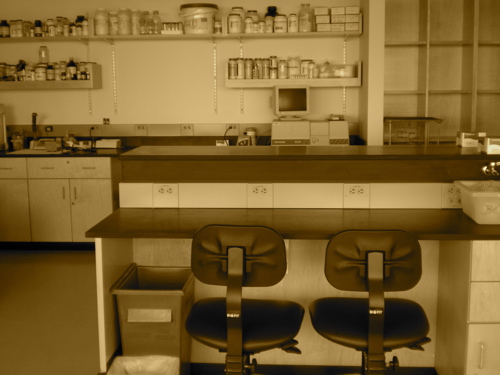20.109(S10):Purify aptamer-encoding DNA (Day2)
Contents
Introduction
Today you will purify your two aptamer-encoding DNA fragments, in preparation for performing an in vitro transcription (IVT) reaction to copy the DNA into RNA. IVT requires specific conditions, so we want to remove everything but our DNA fragment from the PCR (e.g., excess dNTPS), and also change from the PCR buffer into pure water. To accomplish this reaction clean-up, we will first run our entire PCRs through a gel, then excise the band of the correct size (~129 bp).
Explain agarose gel – as old wikis, + emphasis on Hi-Res… From S09M2D3
Explain silica column clean-up – as old wikis…
Protocols
Part 1: Run PCR products on gel
You will use a 3% agarose gel to run your two PCRs from last time, as well as a reference lane of molecular weight markers (also called a DNA ladder).
- Put 25 μL of each reaction from last time (6-5, 8-12, and no template control) into a separate eppendorf tube.
- Add 2.5 μL loading dye to the PCR aliquots.
- Loading dye contains xylene cyanol as a tracking dye to follow the progress of the electrophoresis (so you don’t run the smallest fragments off the end of your gel!) as well as glycerol to help the samples sink into the well.
- Flick the eppendorf tubes to mix the contents, then quick spin them in the microfuge to bring the contents of the tubes to the bottom.
- To quick-spin, hold down the "short" button on your centrifuge for 3-5 seconds, then release.
- Load the gel according the table below.
- To load your samples, draw 25 μL into the tip of your P200. Lower the tip below the surface of the buffer and directly over the well. You risk puncturing the bottom of the well if you lower the tip too far into the well itself (puncturing well = bad!). Expel your sample into the well. Do not release the pipet plunger until after you have removed the tip from the gel box (or you'll draw your sample back into the tip!).
- Once all the samples have been loaded, attach the gel box to the power supply and run the gel at 100 V for 30 minutes.
- You will be shown how to photograph your gel and excise the relevant bands of DNA.
Possibly Neal will come in today for the first time, while gels run
Part 2: Purify DNA
To purify your DNA from the agarose, you will use a kit from the Qiagen company. The reagents in such commercial kits can have uninformative names and their contents are in part proprietary.
- Estimate the volume of your gel slices by weighing them.
- The easiest way to do this is to pre-weigh an eppendorf tube for each slice, then weigh it again after adding the gel, and take the difference.
- Add 3 volumes of QG for every 1 volume of agarose. (The maximum advised volume is 550 ul.)
- Incubate in the 50°C water bath for 15 minutes, until the agarose is completely dissolved. Every few minutes, you should remove your tubes from the 50°C heat and vortex them for a few seconds to help dissolve the agarose.
- Add 1 volume of isopropanol to each eppendorf tube.
- Get two QIAquick columns and two collection tubes from the teaching faculty. Label the spin-column (not the collection tubes!) either “6-5” or “8-12” then pipet the appropriate dissolved agarose mixture to the top. Microfuge the column in the collection tube for 60 seconds at maximum speed (approx. 16,000 rcf). The maximum capacity of the QIAquick columns is 800 uL! If you have more than 800 uL in your mixture, you will need to repeat this step.
- Discard the flow-through in the sink and replace the spin-columns in their collection tubes. Add 500 μL of QG to the top of the column and spin as before.
- Discard the flow-through again, then add 750 μL of PE to the top of the column and incubate for 5 min at room temperature.
- Spin for 1 min as before.
- Discard the flow-through in the sink and replace the spin-columns in their collection tubes. Add nothing to the top but spin for 60 seconds more to dry the membrane.
- Trim the cap off two new eppendorf tubes and prepare sticky labels (in your team color) for the top that say the date and either “6-5” or “8-12.” You may also want to write something on the side of each tube, so you don't lose track of which is which in the following step.
- Place the labeled spin-column in the correct trimmed eppendorf tube and add 30 ul of the pH 7 water to the center of the membrane.
- Do not add the regular distilled water, as this is at a lower pH, which will lower elution efficiency.
- Allow the columns to sit at room temperature for one minute and then spin as before. The material that collects in the bottom of the eppendorf tubes is your purified aptamer-encoding DNA.
